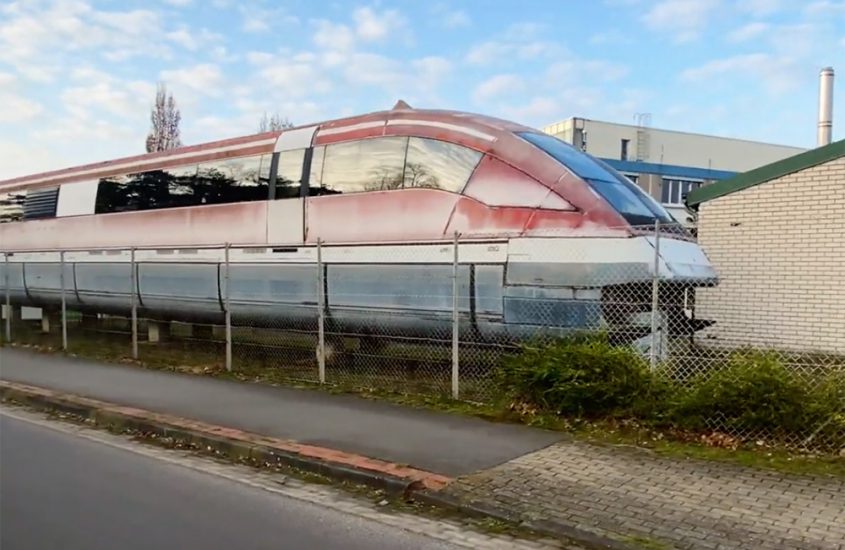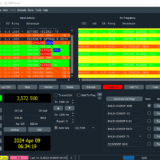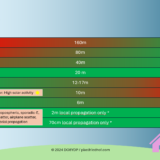The Transrapid technology is rotting away in Emsland

In Emsland we visited the remains of the abandoned Transrapid test track Emsland (TVE). The former high technology had the potential to revolutionize passenger transport. Find out what has happened to it in the video.
Ihre Daten werden erst beim Abspielen des Youtube-Videos an den Dienst übermittelt. Your data will only be transmitted to the service when you play the Youtube video.
Launched in 1969, the Transrapid project was a showcase project of German engineering. The magnetic levitation train developed in Germany reached top speeds of up to 450 km/h.
In the spring of 2006, I was lucky to be able to travel aboard the Transrapid myself at the Transrapid test track in Emsland. At that time, the visitor center was open regularly, and exhibitions and information boards informed visitors about this promising technology. The green staircase building led me to the platform and together with my father and grandfather I took a seat in one of the trains. We felt the incredible acceleration of the train hovering above the concrete pillars. On the almost 32km long test track we experienced the incomparable passenger comfort, the calm in the train and this enormous speed
Today the remains of the exhibition and the platform are locked behind iron gates and padlocks. The Transrapid trains remaining at the depot rot away on the parking tracks. Some train parts are covered under tents, moss, weather and vandalism are chewing on the trains. The former transformer stations are rusting away, although you can still hear the typical whirring of some transformer stations in some parts of the area.
The Transrapid was able to accelerate from standstill to 200 km/h within 60 s and from 200 km/h to 400 km/h in another 60 s. For an acceleration to 300 km/h it needed about four kilometers of track.
In contrast to normal trains, the Transrapid had no rolling resistance. No wheels, axles, drive shafts or transmissions were required for propulsion.
This eliminated friction losses and wear and tear on these classic railway components. Due to the lack of contact with the rail, there was significantly less noise than in a regular train.
After the start of the state-financed development in 1969, the first prototypes were presented in 1979. In 1991 the Transrapid system was recognized as ready for application. The system was thus ready for use from then on and was to revolutionize rail traffic for passengers and goods.
In a Transrapid train formation up to 1172 people could be seated. As a pure cargo variant, the system could have transported as much load per train as an Airbus A380.
Why did this progressive system never become reality?
My personal opinion is that we Germans often first see concerns in innovations before we even consider innovations and benefits. The construction of the test track in the Emsland region alone was considerably delayed due to various concerns of citizens, nature conservationists and politicians. Planning procedures were complicated and a lack of political support cost valuable time for successful international marketing.
The willingness of established rail network operators to introduce the new system was very limited. Although they were pleased to be involved in this media-effective and prestigious project, they were also reluctant to invest in the conversion of existing train paths.
Thus, the inner-German Transrapid projects Berlin-Hamburg, Metrorapid and an airport feeder line in Munich were cancelled after many years of planning without a single productive reference implementation. How were we supposed to sell this solution to the world when the inventor country was already unable to operate the system itself in reality?
In 2004, the only Transrapid line still active today was actually put into regular operation in Shanghai. China has achieved what we have failed for decades. A declaration of bankruptcy for German innovative strength.
In comparison to a German ICE half train, the energy consumption per seat for one kilometer of distance traveled at 300km/h speed was only 28.1 Wh instead of 44.4 Wh for regular high speed trains. From an ecological point of view, this is a factor not to be disregarded, which seems more interesting today than ever before.
On September 22, 2006, a serious accident occurred at the Transrapid test facility in Emsland in which 23 people died and ten others were injured. The Transrapid 08 with 31 passengers collided on an open track with a maintenance car manned by two people. The dispatcher had given the clearance for the maintenance car although the Transrapid 08 was on the line.
57 seconds after the start at 09:53, someone applied the emergency brake, 25 meters later the train crashed into the maintenance car at a speed of 162 km/h. The impact could be heard from far away. The magnetic levitation train, constructed in lightweight construction, drilled its way under the 60-tonne workshop car. The roof of the Transrapid at the head of the train was torn off and the vehicle was pressed together under the workshop car. The wreck, continued to slide along the track for about 300 meters before finally coming to a standstill.
Although human error was identified as the cause of the accident and such an accident could also have occurred on normal railway networks, this terrible accident inevitably stuck to the Transrapid project from that moment on. Another undeniable scratch in the paint of this technologies marketing.
As a result of the accident, the operating license for the test facility was initially revoked, then reissued in July 2008. At the end of 2011, the operating license for the Transrapid test facility in Emsland finally expired.
The remains of the former showcase technology have since been left to their own devices. The fact that today there is not even a museum with visiting facilities is a symbol of how much this innovation has been neglected and underestimated since its invention.



